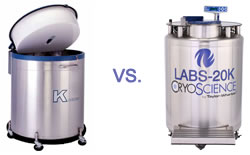Recent News & Events
Cryogenic Storage Wars - Liquid Phase or Vapor Phase LN2 Freezer?
07
 Cryogenic Freezers have used Liquid Nitrogen (LN2) for preservation of biological materials since the 1950’s and LN2 remains the gold standard for long-term cryogenic storage to this day. Originally, the only option was to submerse your biological materials directly into liquid phase nitrogen but advancements in cryogenic storage technology allow modern LN2 freezers to maintain uniform temperatures in the vapor phase that forms above liquid phase nitrogen. While storing your biological materials in liquid nitrogen provides the ultimate in preservation and long-term storage, it is dangerous to work with. Using vapor phase nitrogen freezers protects researchers and provides easier access but storage times are diminished. When you’re deciding which type of Cryogenic Storage Freezer to get, liquid phase or vapor phase nitrogen, you will have to take your specific storage requirements into account and select the LN2 freezer that will best meet your needs. Liquid and vapor phase systems each present distinct advantages that should clarify your selection. If not, you have a third option. You can get an LN2 freezer that contains storage space in separate liquid phase and vapor phase sections.
Cryogenic Freezers have used Liquid Nitrogen (LN2) for preservation of biological materials since the 1950’s and LN2 remains the gold standard for long-term cryogenic storage to this day. Originally, the only option was to submerse your biological materials directly into liquid phase nitrogen but advancements in cryogenic storage technology allow modern LN2 freezers to maintain uniform temperatures in the vapor phase that forms above liquid phase nitrogen. While storing your biological materials in liquid nitrogen provides the ultimate in preservation and long-term storage, it is dangerous to work with. Using vapor phase nitrogen freezers protects researchers and provides easier access but storage times are diminished. When you’re deciding which type of Cryogenic Storage Freezer to get, liquid phase or vapor phase nitrogen, you will have to take your specific storage requirements into account and select the LN2 freezer that will best meet your needs. Liquid and vapor phase systems each present distinct advantages that should clarify your selection. If not, you have a third option. You can get an LN2 freezer that contains storage space in separate liquid phase and vapor phase sections.
Cryogenic storage freezers that preserve biological materials in liquid phase nitrogen provide a cost-effective and efficient way for you to maintain the extremely low temperatures you need for cryogenic storage. LN2 freezers with liquid phase storage ensure that all biological activity has ceased, placing cells in a state of suspended animation, theoretically for centuries. In traditional liquid phase cryogenic freezers, your samples are stored completely submerged in liquid nitrogen. This ensures that your samples are kept at a consistent temperature throughout their storage time. As long as you maintain a sufficient supply of liquid nitrogen, the temperature of your samples will remain at or below -196°C indefinitely. At temperatures of -196°C or less, all cell activity ceases so your sample should theoretically never degrade. Liquid phase systems date back to the beginning of LN2 cryogenic technology and because of their ability to maintain the consistent low temperatures required, they remain the workhorses at the heart of cryogenic sample preservation. This consistency is critical for preservation and long term storage when you want cell samples in exactly the same condition fifty years from now as they were the day you froze them.
Choosing between the long-term storage benefits that liquid phase LN2 freezers provide and the ease of access that vapor phase LN2 freezers provide can sometimes be difficult. However, if you want to have frequent access to your samples (which will expose your samples to temperature fluctuations anyway) then a vapor phase system will make retrieval easier and much safer. We’ve established that biological activity ceases at -196°C and submersion in LN2 is required to reach those temperatures but, cell activity effectively stops at -135°C allowing your samples to be stored at or below this temperature without any significant deterioration. That’s where vapor phase LN2 freezers, which operate at specific temperature ranges between -135°C and -190°C depending on the model, become a useful alternative. Your project requirements will dictate the type of LN2 freezer that is right for your specific situation. Generally, a good rule of thumb is that if you want longer term storage, the liquid phase is better because it maintains your sample at a lower, more consistent temperature but for other situations where long-term storage is not a factor, especially when frequent access is required, going with the safety and ease of access that vapor phase LN2 freezers provide may be a better option.
